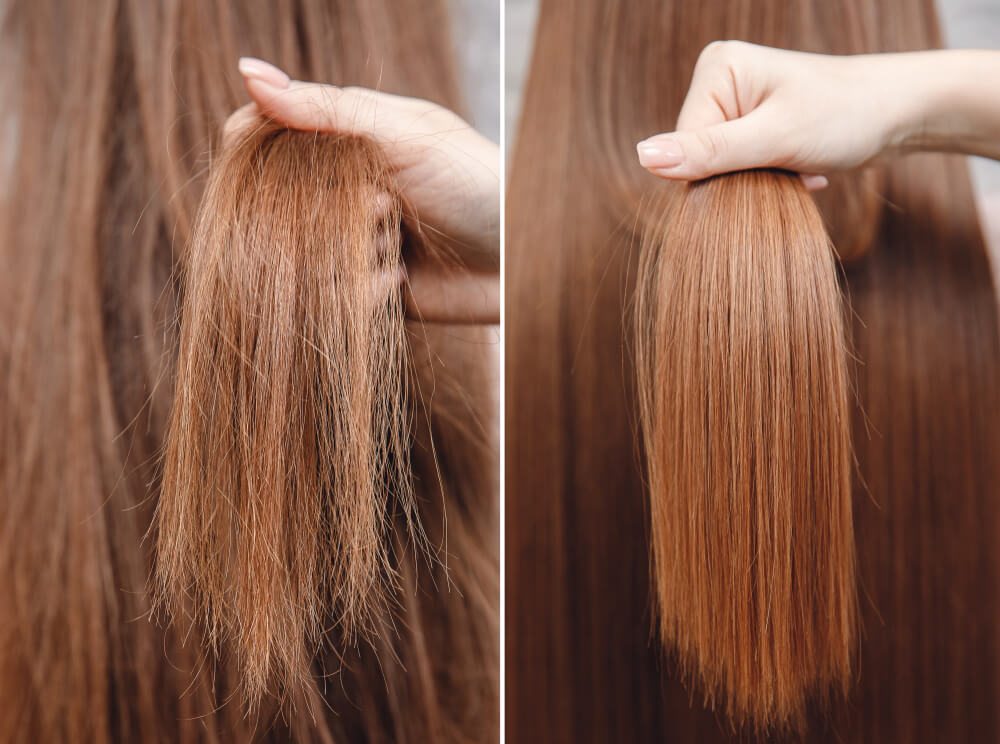Your hair is your crown, and like any prized possession, it deserves care and attention. Whether it’s due to heat styling, chemical treatments, coloring, or environmental exposure, hair damage can sneak up on anyone. The good news? Damaged hair isn’t a lost cause. With the right techniques and a little patience, you can restore your hair’s health, shine, and strength. Here are 9 essential tips that truly work to repair damaged hair and bring back its natural beauty.

1. Trim the Damage
Let’s face it—split ends won’t magically heal. Trimming your hair is the first step in damage control. If you notice split, dry, or frizzy ends, snip them off. Regular trims (every 6-8 weeks) help prevent further breakage and give your hair a healthier look and feel. Even if you’re growing out your hair, trimming just a little can save you a lot in the long run.
2. Switch to Sulfate-Free Shampoo
Sulfates are harsh detergents found in many shampoos. They strip away natural oils, leaving hair dry, brittle, and more prone to breakage. A sulfate-free shampoo gently cleanses without over-drying your strands. Look for formulas that include nourishing ingredients like argan oil, keratin, or coconut oil to help hydrate and restore hair health.
3. Deep Condition Weekly
One of the most effective ways to treat damaged hair is through deep conditioning treatments. These products penetrate the hair shaft to deliver moisture and protein—two things damaged hair desperately needs. Use a deep conditioner or hair mask once or twice a week. For best results, apply it after shampooing, leave it on for 15-30 minutes (or as directed), and then rinse thoroughly. You can also wrap your hair in a warm towel for deeper penetration.
4. Limit Heat Styling
Heat is one of the top culprits behind hair damage. Blow-dryers, curling irons, and straighteners can weaken the hair shaft and lead to breakage. Try to air-dry your hair whenever possible and limit heat styling to special occasions. When you do use heat, always apply a heat protectant spray to create a barrier between your hair and the high temperatures. Also, use tools with adjustable heat settings and keep them on the lowest effective temperature.
5. Use a Leave-In Conditioner
Leave-in conditioners are a great way to keep your hair moisturized throughout the day. They provide ongoing hydration, reduce frizz, and make detangling easier—all of which are crucial for preventing breakage. Choose a lightweight leave-in for fine hair and a creamy one for thick, curly, or coily hair. You can even look for ones with added benefits like UV protection or anti-breakage formulas.
6. Protect Hair While Sleeping
Your hair is vulnerable even while you sleep. Tossing and turning can cause friction that leads to breakage and split ends. Here’s what you can do to protect your hair overnight:
- Sleep on a silk or satin pillowcase – it reduces friction and keeps moisture locked in.
- Tie your hair in a loose braid or bun to prevent tangling.
- Use a satin or silk scarf or bonnet for extra protection, especially for curly or textured hair.
Small changes at night can lead to big improvements over time.
7. Nourish From Within
Your hair’s health isn’t just about what you put on it—it’s also about what you put in your body. A balanced diet rich in vitamins and minerals is essential. Key nutrients for healthy hair include:
- Protein: Hair is made of keratin, a protein. Include lean meats, eggs, beans, and nuts in your diet.
- Omega-3 Fatty Acids: Found in fish, chia seeds, and walnuts, these keep the scalp hydrated.
- Biotin and Vitamin E: Promote hair strength and shine. Found in spinach, almonds, and sweet potatoes.
Hydration is just as important—drink enough water daily to maintain moisture balance in your hair.
8. Avoid Over-Washing
Washing your hair every day can strip away its natural oils, leaving it dry and vulnerable. Most hair types do well with 2-3 washes per week. In between, you can use a dry shampoo to absorb excess oil and keep your scalp feeling fresh. When you do wash, focus on the scalp to remove dirt and buildup, and let the shampoo rinse down the rest of your hair without over-scrubbing the ends.
9. Incorporate Natural Oils
Nature provides some of the best remedies for damaged hair. Natural oils like coconut oil, argan oil, olive oil, and castor oil are rich in fatty acids and antioxidants that can revive dry, brittle hair. Here’s how to use them:
- Coconut oil penetrates the hair shaft and helps reduce protein loss.
- Argan oil is lightweight and perfect for smoothing and adding shine.
- Castor oil promotes hair growth and thickening.
- Olive oil deeply moisturizes and strengthens.
Warm the oil slightly and massage it into your scalp and hair, then leave it on for 30 minutes (or overnight) before rinsing. Use these oil treatments once or twice a week for best results.

Final Thoughts
Hair damage doesn’t have to be permanent. With consistent care, the right products, and a few simple changes to your routine, you can restore your hair’s health, softness, and shine. Remember, the journey to healthy hair is a marathon, not a sprint. Stay patient and stay kind to your hair—you’ll start seeing the results in just a few weeks.
Whether you’re dealing with dryness, breakage, or split ends, these 9 essential tips will help you regain control and bring your hair back to life. Start small, be consistent, and give your hair the love it deserves.
